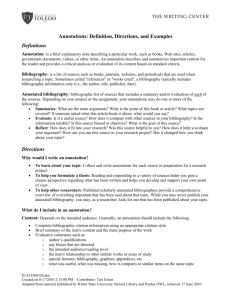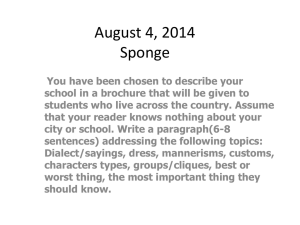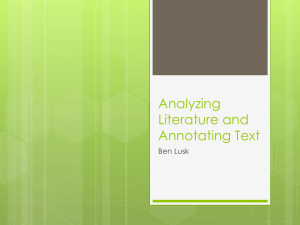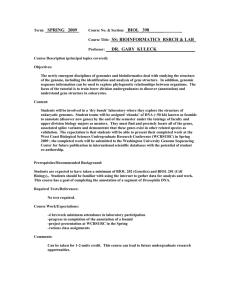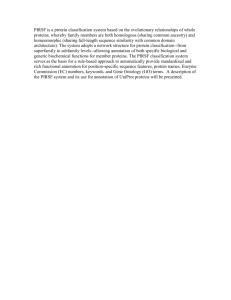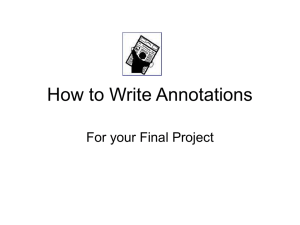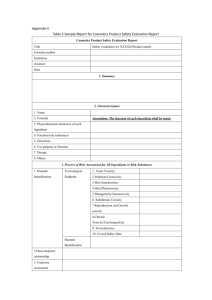How to Write an Annotation
advertisement
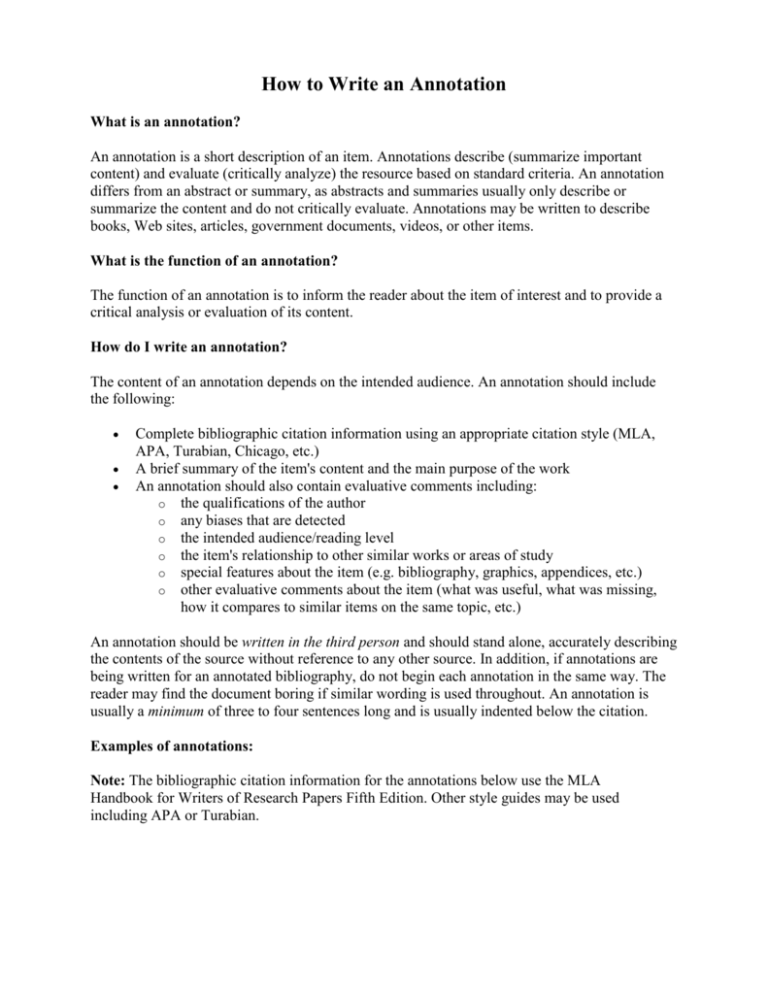
How to Write an Annotation What is an annotation? An annotation is a short description of an item. Annotations describe (summarize important content) and evaluate (critically analyze) the resource based on standard criteria. An annotation differs from an abstract or summary, as abstracts and summaries usually only describe or summarize the content and do not critically evaluate. Annotations may be written to describe books, Web sites, articles, government documents, videos, or other items. What is the function of an annotation? The function of an annotation is to inform the reader about the item of interest and to provide a critical analysis or evaluation of its content. How do I write an annotation? The content of an annotation depends on the intended audience. An annotation should include the following: Complete bibliographic citation information using an appropriate citation style (MLA, APA, Turabian, Chicago, etc.) A brief summary of the item's content and the main purpose of the work An annotation should also contain evaluative comments including: o the qualifications of the author o any biases that are detected o the intended audience/reading level o the item's relationship to other similar works or areas of study o special features about the item (e.g. bibliography, graphics, appendices, etc.) o other evaluative comments about the item (what was useful, what was missing, how it compares to similar items on the same topic, etc.) An annotation should be written in the third person and should stand alone, accurately describing the contents of the source without reference to any other source. In addition, if annotations are being written for an annotated bibliography, do not begin each annotation in the same way. The reader may find the document boring if similar wording is used throughout. An annotation is usually a minimum of three to four sentences long and is usually indented below the citation. Examples of annotations: Note: The bibliographic citation information for the annotations below use the MLA Handbook for Writers of Research Papers Fifth Edition. Other style guides may be used including APA or Turabian. Web Site Caffeine. 3 April 2002. McKinley Health Center. 22 January 2003. <http://www.mckinley.uiuc.edu/health-info/drug-alc/caffeine.html>. This Web site discusses the ingredient caffeine. On the site many questions are answered about caffeine including its effects and safety, reducing caffeine consumption, and whether or not it helps with studying. The amount of caffeine in common foods is listed in a table at the bottom of the page including various types of coffee and teas, chocolate, cocoa, and soft drinks. Medications that contain caffeine are also listed. The page is well-organized, contains useful information, and includes appropriate documentation. Scholarly Journal Article Speckmann, Bettina and Jack Snoeyink. "Easy Triangle Strips for TIN Terrain Models." International Journal of Geographical Information Science 15 (2001): 379-386. This technical communication discusses the triangulated irregular network (TIN) model to represent feature terrain. A major problem with this model is the amount of data required in transmission. To reduce the amount of data transmitted, many systems use triangle strips or tristrips. The goal of the tristrip concept is to find the minimum number of vertices to accurately represent the terrain. Two methods to create this tristrip representation are described. The paper contains a variety of figures and a table to assist the reader in understanding the concept of tristrips and ends with a short list of references. The authors, Speckmann and Snoeyink, work in the departments of computer science at the University of British Columbia and UNC Chapel Hill, respectively. Book Barber, Benjamin R. Jihad vs. McWorld: How Globalism and Tribalism are Reshaping the World. New York: Ballentine Books, 1996. In this book, Benjamin Barber discusses globalism, tribalism, democracy, and capitalism. Part I discusses McWorld and its invasion throughout the entire world. Barber writes that this global overtaking has been accomplished through music, various service industries, and the media. Part II focuses on Jihad, in opposition to McWorld, as people and countries struggle for their own individual and cultural identities. Part III describes the clash of McWorld and Jihad and the resulting disorder. Capitalism and democracy are debated as working against each other. Two appendices are included at the end of the book. The first appendix describes energy use and population by country in 1990 and the second lists the twenty-two countries' top grossing films in 1991. The book also includes an extensive notes section. The book was well-organized and the material covered presents globalization in a new way. Popular Magazine Article Thompson, Stephanie. "Targeting Teens Means Building Buzz." Advertising Age 27 March 2000: 26. This brief article discusses marketing to teens without their knowing that they are directly being targeted. Different strategies used to market products are described including those used for Cornnuts and Nabisco's Bubble Yum gum. The article describes this marketing as "anti-advertising" and portrays how teens react to various tactics. Although short, this article provides a current overview of how companies market to teens. Newspaper Article Blake, Catherine S. “University of Utah Receives $11 Million to Study Addition.” Standard-Examiner [Ogden] 17 Jan. 2003: 6B. This newspaper article discusses a project to study people addicted to nicotine. The study will focus both on mice and people to identify genes which may lead to addiction. It will also focus on predisposition of certain populations to lung diseases including emphysema and bronchitis. Participants in the study will be from Utah and the University of Wisconsin. Studying people in Utah is an important aspect of the study due to the large families with similar genes and the culture of intolerance towards smoking. The article was well-written and describes a variety of aspects involved in the study. The author consulted several faculty members from the University of Utah in writing the article. Government Document United States. Environmental Protection Agency. Office of Water. WAVE: Water Management for the 21st Century. Washington: GPO, 1999. This pamphlet produced by the Office of Water in the Environmental Protection Agency describes the contentious issue of water use and outlines a voluntary program called Water Alliances for Voluntary Efficiency (WAVE) to conserve freshwater supplies. WAVE member objectives are summarized and a description of how WAVE supports its members through outreach materials and other publicity methods is described. The pamphlet was produced to influence people to join this voluntary program and statistics and success stories of water conservation are effectively used to realize this purpose.
